Ultrafiltration Plant Models Efficiency
Little more than five years ago, the Bexar Metropolitan Development Corporation in San Antonio, Texas, contracted United Water Services to design and build the largest membrane ultrafiltration treatment plant in the United States at the time. The goal was to utilize the nearby Medina River as source water in an efficient facility that United Water would continue to operate.
Now, the Bexar (pronounced “Bear”) Metropolitan Ultra-filtration Water Treatment System demonstrates a production capacity of 10.8 MGD in winter and a firm 14.5 MGD in summer – similar to that of a conventional plant three times its size. Staffed by four full-time United Water employees, it consistently produces superior-quality water at a total cost of $1.25 per 1,000 gallons, including $0.65 of debt service, $0.20 of capital replacement cost, and $0.40 operating costs.
Key to this success: Using powerful clarification prior to membrane filtration and reliable process automation based on readings from ultra-sensitive laser nephelometers.
Pretreatment increases efficiency
United Water installed a Superpulsator® Clarifier (Infilco Degremont) – customized by adding settler tubes to create an ‘ultrapulsator’ – that applies vacuum pulsation to facilitate settling and removal of suspended solids, organics, and pathogens. “We reduce raw water turbidity, typically 10 to 40 NTU but sometimes much higher, to about 0.6 to 1.0 NTU with only ferric sulfate coagulant,” explained Joseph Thaxton, Project Manager for United Water.
Subsequent treatment with 0.01-micron, hollow cellulose acetate fiber membranes (Aquasource™ Ultrafiltration Membrane, from Infilco Degremont) removes pollen, algae, parasites, bacteria, viruses, fungi, and cysts to yield a combined membrane permeate turbidity of 10 to 20 milli-NTU (0.01 to 0.02 NTU). The plant enjoys 3-log removal credit for Giardia lamblia cysts and a 2-log removal credit for viruses.
The initial upflow clarification also reduces chlorine demand of membrane permeate and the subsequent level of chlorination and potential disinfection by-products. “The clarifier upstream of the membranes is where they’re removing THM-precursors,” acknowledged Don White, Environmental Investigator IV of the Public Water Supply Division of the Texas Commission on Environmental Quality (TCEQ). “You’ve got to hand it to United Water and BexarMet for putting these two high-performance components together.”
Laser nephelometer surveillance
The TCEQ specifies the performance of each membrane rack of a microfiltration or ultrafiltration installation be monitored by a particle counting or monitoring device or a laser nephelometer applying USEPA-approved Method 10133. United Water installed eight units of the FilterTrak 660™ Nephelometer (Hach Company), which, according to Thaxton, provide the breakthrough detection ability of particle counters and are easy to calibrate and maintain. Nephelometer output to the plant’s programmable logic controller (PLC)-based system supports automated process control.
“Absolutely, these instruments are vital in producing superb water while reducing manned operation to one shift a day from Monday through Friday,” Thaxton affirmed. “With automated alarming capability, we start investigating the process if the nephelometer readings exceed 30 milli-NTU.”
